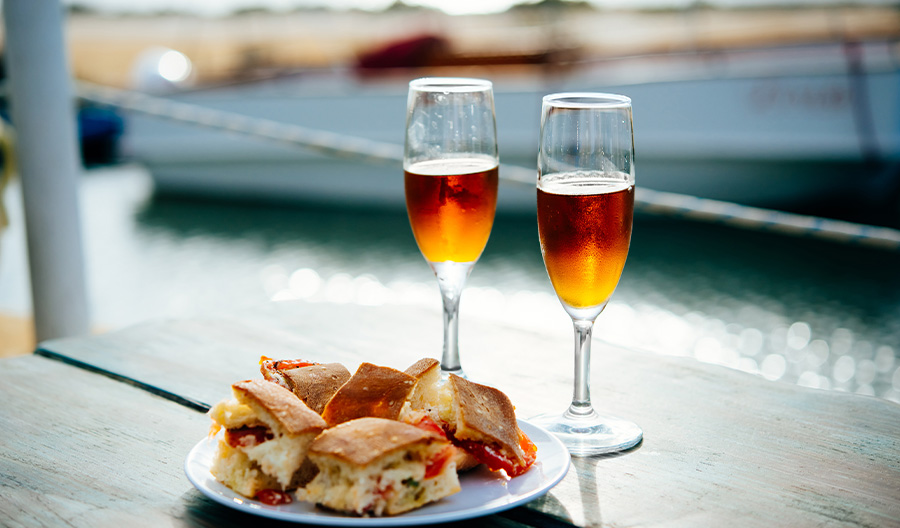When Americans hear the word Marsala they usually think of a bad chicken dish at a wedding buffet. But wine professionals say that if people knew how magical Marsala could be in a glass, they would think again.
Once sought out by oenophiles all over the world, this Sicilian fortified wine, which has been produced for centuries, if not millennia, fell out of fashion in the mid-twentieth century and hasn’t quite regained its footing. And that’s a shame.
“I wish I could say that Marsala is back to all its glory, but unfortunately most Americans might not realize the nobility and care that goes into producing Marsala,” says Shelley Lindgren, co-owner and wine director of the A16 restaurants in California’s Bay Area and co-author of three Italian wine books.
“I think most people still think of Marsala as strictly a cooking wine,” says Joe Campanale, co-owner of restaurants Fausto and Lalou in New York City and author of Vino: The Essential Guide to Real Italian Wine. “Our guests are often surprised when I tell them that Marsala can be an elegant and complex sipping wine.”
Relegated to the bottom shelf by far too many consumers, Marsala is ripe for discovery.
What Is Marsala, Exactly?
If industry experts agree that getting serious about Marsala is worthwhile, they also agree that this wine can be hard to describe. It’s possible that this Sicilian fortified wine’s biggest problem is how many things it can be and how hard it is to pin down.
This much is true: To be legally labeled Marsala, a wine must be made in the northwest corner of Sicily from grapes indigenous to the region, with Grillo being the most appreciated of those, and then fortified (that is, strengthened with must or distilled spirit) before bottling.
The Styles of Marsala, Explained
There are three styles of Marsala: oro, ambra and rubino. There are also five aging designations: fine (aged at least one year), superiore (two), superiore riserva (four), vergine (five) and vergine stravecchio (ten or more years).

The History of Marsala
Most people will say that Marsala was popularized by the English in the late 18th century as the world was falling into the era of colonialism and the market for wine that could travel was expanding. But the Marsala region of Sicily had long been producing this unique style of wine by the time the English arrived.
Renato de Bartoli, who joined his father Marco in an effort to revive a pre-British style of Marsala production in the 1990s, points out that more than 2,000 years ago, the Phoenicians already shipped the wines of Marsala to their colonies across the Mediterranean. Only then, Marsala wines weren’t fortified. Instead it was produced by a method known as “in perpetuum,” which saw a Solera-style multi-vessel aging process.
In the 1960s, the global market for wine was growing and super-producers like Sicily began to favor quantity over quality. The slow-moving traditional process was often modified in favor of using chaptalization, fortification or the addition of cooked grape must to make Marsala ready for market faster. And the diversity of production methods made the wine increasingly difficult to categorize, while cutting corners deteriorated its reputation.
As a result, many of the finest producers of Marsala now make wines that are not even labeled as such, wishing to return to older practices that pre-date this turn, or even the earlier British intrusion.
Getting Back to Greatness
Gabriele Gorelli, the first (and still only) Master of Wine in Italy, observes that given the prodigious memory of the wine-drinking world, people of a certain generation might still understand Marsala can be great, but that vision is fading, and younger drinkers are disconnected from its once-greatness.
To be sure, the identity-nomenclature problem is one Marsala shares with all Italian wine, points out Andrea Mancìn, wine director at LaRina in New York City. It puts at risk the loss of Marsala’s territorial identity, which is what he sees as Marsala’s only way forward. De Bartoli agrees, emphasizing that it must be tied to its place of origin, showing its Sicilian identity no matter what face it presents.
This history combined with the many faces of this unique wine is what so impresses the winery director of a major Marsala producer. He calls the wine “a love story.”
He points out that Marsala is so exciting because it can reproduce the vicissitudes of a long-term relationship: It can be challenging, but is constantly evolving. It becomes even more rewarding with investment. And on the subject of investment, Marsala remains an absolutely screaming deal for anyone who wants to dip a toe in this part of the Sicilian wine sea.
Even the highest-quality Marsala arrives at relatively affordable price points considering how age-worthy, exciting and profound it can be.

